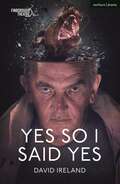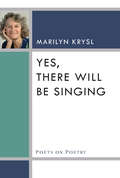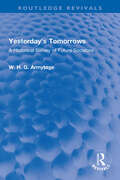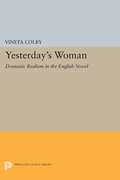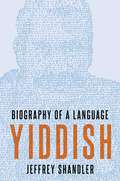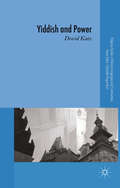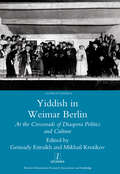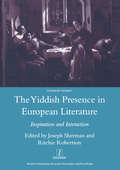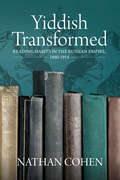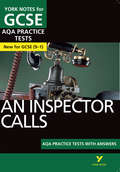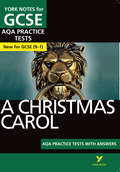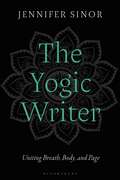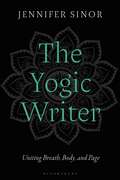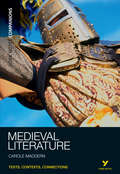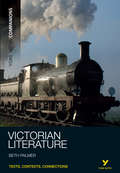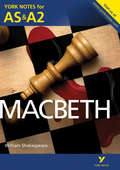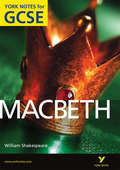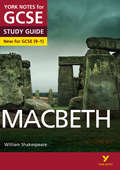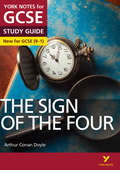- Table View
- List View
Yes So I Said Yes (Modern Plays)
by David IrelandIt's harder to kill people when there's a peace process on.Ulster Loyalist Alan Black is kept awake every night by his neighbour McCorrick's dog barking. To add to his difficulties, McCorrick refuses to acknowledge that he even owns a dog, let alone one that is creating a disturbance.In a Northern Ireland he barely recognises, where politics has proved just to be the continuation of war by other means, a disconsolate Alan sets out to rid himself of the incessant noise. As he seeks help from authority figures, he finally – as a very last resort – turns to the only voice he can really trust, Eamonn Holmes…Coinciding with the 100th anniversary of the partition of Ireland and the foundation of Northern Ireland, Yes So I Said Yes is a blackly comic, ferocious, dystopian satire about what it's like to feel alone in a place where everyone else is conspiring to erase you and your history.This edition was published to coincide with the production at London's Finborough Theatre in November 2021.
Yes, There Will Be Singing: Yes, There Will Be Singing (Poets On Poetry)
by Marilyn KryslYes, There Will Be Singing brings together Marilyn Krysl’s essays on the origins of language and poetry, poetic form, the poetry of witness, and poetry’s collaboration with the healing arts. Beginning with pieces on her own origins as a poet, she branches into poetry’s profound spiritual and political possibilities, drawing on rich examples from poets such as Anna Akhmatova, W.S. Merwin, and Vénus Khoury-Ghata. Krysl concludes with a selection of stories of her nursing and humanitarian work, powerfully connecting poetic expression with a generous and compassionate worldview.
Yesterday's Tomorrows: A Historical Survey of Future Societies (Routledge Revivals)
by W. H. ArmytageFirst published in 1968, Yesterday’s Tomorrows elucidates on the favourite occupation of man: forecasting the future. By man’s predictions, he mirrors his own wish-fulfilments, displacements, projections, denials, evasions and withdrawals. These predications can take the form of countries of the imagination, ‘mirror worlds’ like Rabelais’ Ever-Ever lands or the Erewhon of Butler. Alternatively, they may spring from panic, reflecting fear rather than hope, often manifesting themselves, in our technological age, as reports of ‘flying saucers’ or invasions from another planet. In either form, they provide philosophers, scientists, doctors and sociologists with material for evaluating man’s future needs, offering both criticism of our present society, plans for our future, and release from tension and disequilibrium. Professor Armytage shows in this book how such ‘visions’ can, and do, refresh minds for renewed grappling with the present by arming them with ideas for man’s future needs. He indicates that, out of an apparent welter of futuristic fantasies, a constructive debate about tomorrow is emerging, providing us with operational models of what tomorrow could be. This book will hold special interest for students of philosophy and of English literature.
Yesterday's Tomorrows: A Historical Survey of Future Societies (Routledge Revivals)
by W. H. ArmytageFirst published in 1968, Yesterday’s Tomorrows elucidates on the favourite occupation of man: forecasting the future. By man’s predictions, he mirrors his own wish-fulfilments, displacements, projections, denials, evasions and withdrawals. These predications can take the form of countries of the imagination, ‘mirror worlds’ like Rabelais’ Ever-Ever lands or the Erewhon of Butler. Alternatively, they may spring from panic, reflecting fear rather than hope, often manifesting themselves, in our technological age, as reports of ‘flying saucers’ or invasions from another planet. In either form, they provide philosophers, scientists, doctors and sociologists with material for evaluating man’s future needs, offering both criticism of our present society, plans for our future, and release from tension and disequilibrium. Professor Armytage shows in this book how such ‘visions’ can, and do, refresh minds for renewed grappling with the present by arming them with ideas for man’s future needs. He indicates that, out of an apparent welter of futuristic fantasies, a constructive debate about tomorrow is emerging, providing us with operational models of what tomorrow could be. This book will hold special interest for students of philosophy and of English literature.
Yesterday's Woman: Domestic Realism in the English Novel
by Vineta ColbyEncouraged by the response of the avid novel-reading public in early nineteenth-century England, minor novelists produced a staggering number of volumes that shaped styles, formed attitudes, and gave to the novel a new status and respectability. These novels were read by both sexes, but the majority were written by women. Vineta Colby examines the works of such minor novelists as Mrs. Gore, Maria Edgeworth, Charlotte Yonge, and Harriet Martincau, arguing that they prepared the way for the novels of the great Victorian era.Antiromantic and bourgeois in spirit, these domestic novels were concerned with daily living in ordinary society. As the form developed, the novels turned away from "idle romance" to a serious treatment of basic questions of human and social values. Professor Colby demonstrates how the preoccupation with high society, childhood, and village life laid the thematic foundations for the more sophisticated works of the later Victorians. The author concludes by showing that the disruption of the family unit by technology, urbanization, and scientific materialism led the domestic novel into the realms of literary naturalism and social realism.Originally published in 1974.The Princeton Legacy Library uses the latest print-on-demand technology to again make available previously out-of-print books from the distinguished backlist of Princeton University Press. These editions preserve the original texts of these important books while presenting them in durable paperback and hardcover editions. The goal of the Princeton Legacy Library is to vastly increase access to the rich scholarly heritage found in the thousands of books published by Princeton University Press since its founding in 1905.
Yiddish: Biography of a Language
by Jeffrey ShandlerThe most widely spoken Jewish language on the eve of the Holocaust, Yiddish continues to play a significant role in Jewish life today, from Hasidim for whom it is a language of daily life to avant-garde performers, political activists, and LGBTQ writers turning to Yiddish for inspiration. Yiddish: Biography of a Language presents the story of this centuries-old language, the defining vernacular of Ashkenazi Jews, from its origins to the present. Jeffrey Shandler tells the multifaceted history of Yiddish in the form of a biographical profile, revealing surprising insights through a series of thematic chapters. He addresses key aspects of Yiddish as the language of a diasporic population, whose speakers have always used more than one language. As the vernacular of a marginalized minority, Yiddish has often been held in low regard compared to other languages, and its legitimacy as a language has been questioned. But some devoted Yiddish speakers have championed the language as embodying the essence of Jewish culture and a defining feature of a Jewish national identity. Despite predictions of the demise of Yiddish-dating back well before half of its speakers were murdered during the Holocaust-the language leads a vibrant, evolving life to this day.
Yiddish: Biography of a Language
by Jeffrey ShandlerThe most widely spoken Jewish language on the eve of the Holocaust, Yiddish continues to play a significant role in Jewish life today, from Hasidim for whom it is a language of daily life to avant-garde performers, political activists, and LGBTQ writers turning to Yiddish for inspiration. Yiddish: Biography of a Language presents the story of this centuries-old language, the defining vernacular of Ashkenazi Jews, from its origins to the present. Jeffrey Shandler tells the multifaceted history of Yiddish in the form of a biographical profile, revealing surprising insights through a series of thematic chapters. He addresses key aspects of Yiddish as the language of a diasporic population, whose speakers have always used more than one language. As the vernacular of a marginalized minority, Yiddish has often been held in low regard compared to other languages, and its legitimacy as a language has been questioned. But some devoted Yiddish speakers have championed the language as embodying the essence of Jewish culture and a defining feature of a Jewish national identity. Despite predictions of the demise of Yiddish-dating back well before half of its speakers were murdered during the Holocaust-the language leads a vibrant, evolving life to this day.
Yiddish and Power: Ten Overhauls Of A Stateless Language (Palgrave Studies in Minority Languages and Communities)
by D. KatzYiddish and Power surveys the social, linguistic and intellectual history of the Yiddish language within the traditional civilisation of Jewish Ashkenaz in central, and then in eastern Europe, and its interaction with the surrounding non-Jewish culture. It explores the various ways in which Yiddish has empowered masses and served political agendas.
Yiddish in Weimar Berlin: At the Crossroads of Diaspora Politics and Culture
by Gennady Estraikh"Berlin emerged from the First World War as a multicultural European capital of immigration from the former Russian Empire, and while many Russian emigres moved to France and other countries in the 1920s, a thriving east European Jewish community remained. Yiddish-speaking intellectuals and activists participated vigorously in German cultural and political debate. Multilingual Jewish journalists, writers, actors and artists, invigorated by the creative atmosphere of the city, formed an environment which facilitated exchange between the main centres of Yiddish culture: eastern Europe, North America and Soviet Russia. All this came to an end with the Nazi rise to power in 1933, but Berlin remained a vital presence in Jewish cultural memory, as is testified by the works of Sholem Asch, Israel Joshua Singer, Zalman Shneour, Moyshe Kulbak, Uri Zvi Grinberg and Meir Wiener. This volume includes contributions by an international team of leading scholars dealing with various aspects of history, arts and literature, which tell the dramatic story of Yiddish cultural life in Weimar Berlin as a case study in the modern European culture."
Yiddish in Weimar Berlin: At the Crossroads of Diaspora Politics and Culture
by Gennady Estraikh"Berlin emerged from the First World War as a multicultural European capital of immigration from the former Russian Empire, and while many Russian emigres moved to France and other countries in the 1920s, a thriving east European Jewish community remained. Yiddish-speaking intellectuals and activists participated vigorously in German cultural and political debate. Multilingual Jewish journalists, writers, actors and artists, invigorated by the creative atmosphere of the city, formed an environment which facilitated exchange between the main centres of Yiddish culture: eastern Europe, North America and Soviet Russia. All this came to an end with the Nazi rise to power in 1933, but Berlin remained a vital presence in Jewish cultural memory, as is testified by the works of Sholem Asch, Israel Joshua Singer, Zalman Shneour, Moyshe Kulbak, Uri Zvi Grinberg and Meir Wiener. This volume includes contributions by an international team of leading scholars dealing with various aspects of history, arts and literature, which tell the dramatic story of Yiddish cultural life in Weimar Berlin as a case study in the modern European culture."
The Yiddish Presence in European Literature: Inspiration and Interaction: Selected Papers Arising from the Fourth and Fifth International Mendel Friedman Conference
by Joseph Sherman"Early in the twentieth century, Yiddish, previously stigmatized as a corrupt jargon, came to be recognized as a language in its own right, and one moreover that was already the vehicle for a rich literature. Many writers in other European languages steadily became aware of the status and richness of the Yiddish language, sometimes by encountering Yiddish-speaking communities in Eastern Europe, and they responded to Yiddish language and culture in their own works, while Yiddish writers adopted, and sometimes anticipated, modern trends in other European literatures known to them. The collection of papers in this volume examines some of these fruitful interactions between Yiddish and the European literary tradition, ranging from the early nineteenth century to the present, from France to Lithuania, and from classic modernist writers such as Kafka to Imre Kertesz (Nobel Prize for Literature, 2002). With the contributions: Gilles Rozier- 'When Purim-shpiler meets Columbine': Characters of Commedia dell'arte and Purimshpil in the Works of Moyshe Broderzon David Bellos- In the Worst Possible Taste: Romain Gary's Dance of Genghis Cohn Florian Krobb- 'Muthwillige Faschingstracht': The Presence of Yiddish in Nineteenth-Century German Literature Ritchie Robertson- Kafka's Encounter with the Yiddish Theatre David Groiser- Translating Yiddish: Martin Buber and David Pinski Mikhail Krutikov- Yiddish Author as Cultural Mediator: Meir Wiener's Unpublished Novel David Midgley- The Romance of the East: Encounters of German-Jewish Writers with Yiddish-Speaking Communities, 1916-27 PolO Dochartaigh - Intimacy and Alienation: Yiddish in the Works of Jurek Becker Peter Sherwood- 'Living through Something': Notes on the Work of Imre Kertesz Joseph Sherman- Bergelson and Chekhov: Convergences and Departures Gennady Estraikh- Shmuel Gordon: A Yiddish Writer in 'the Ocean of Russian Literature'"
The Yiddish Presence in European Literature: Inspiration and Interaction: Selected Papers Arising from the Fourth and Fifth International Mendel Friedman Conference
by Joseph Sherman"Early in the twentieth century, Yiddish, previously stigmatized as a corrupt jargon, came to be recognized as a language in its own right, and one moreover that was already the vehicle for a rich literature. Many writers in other European languages steadily became aware of the status and richness of the Yiddish language, sometimes by encountering Yiddish-speaking communities in Eastern Europe, and they responded to Yiddish language and culture in their own works, while Yiddish writers adopted, and sometimes anticipated, modern trends in other European literatures known to them. The collection of papers in this volume examines some of these fruitful interactions between Yiddish and the European literary tradition, ranging from the early nineteenth century to the present, from France to Lithuania, and from classic modernist writers such as Kafka to Imre Kertesz (Nobel Prize for Literature, 2002). With the contributions: Gilles Rozier- 'When Purim-shpiler meets Columbine': Characters of Commedia dell'arte and Purimshpil in the Works of Moyshe Broderzon David Bellos- In the Worst Possible Taste: Romain Gary's Dance of Genghis Cohn Florian Krobb- 'Muthwillige Faschingstracht': The Presence of Yiddish in Nineteenth-Century German Literature Ritchie Robertson- Kafka's Encounter with the Yiddish Theatre David Groiser- Translating Yiddish: Martin Buber and David Pinski Mikhail Krutikov- Yiddish Author as Cultural Mediator: Meir Wiener's Unpublished Novel David Midgley- The Romance of the East: Encounters of German-Jewish Writers with Yiddish-Speaking Communities, 1916-27 PolO Dochartaigh - Intimacy and Alienation: Yiddish in the Works of Jurek Becker Peter Sherwood- 'Living through Something': Notes on the Work of Imre Kertesz Joseph Sherman- Bergelson and Chekhov: Convergences and Departures Gennady Estraikh- Shmuel Gordon: A Yiddish Writer in 'the Ocean of Russian Literature'"
Yiddish Transformed: Reading Habits in the Russian Empire, 1860-1914
by Nathan CohenAs significant economic, social, political, and cultural transformations swept the Jewish population of Tsarist Russia and Congress Poland between 1860 and 1914, the Yiddish language (Zhargon) began to gain recognition as a central part of the Jewish cultural stage. Yiddish Transformed examines the secular reading habits of East-European Jews as the Jewish community began shifting to a modern society. Author Nathan Cohen explores Jewish reading practices alongside the rise of Yiddish by delving into publishing policies of Yiddish books and newspapers, popular literary genres of the time, the development of Jewish public libraries, as well as personal reflections of reading experiences.
Yiddish Transformed: Reading Habits in the Russian Empire, 1860-1914
by Nathan CohenAs significant economic, social, political, and cultural transformations swept the Jewish population of Tsarist Russia and Congress Poland between 1860 and 1914, the Yiddish language (Zhargon) began to gain recognition as a central part of the Jewish cultural stage. Yiddish Transformed examines the secular reading habits of East-European Jews as the Jewish community began shifting to a modern society. Author Nathan Cohen explores Jewish reading practices alongside the rise of Yiddish by delving into publishing policies of Yiddish books and newspapers, popular literary genres of the time, the development of Jewish public libraries, as well as personal reflections of reading experiences.
Yiddish Transformed: Reading Habits in the Russian Empire, 1860-1914
by Nathan CohenAs significant economic, social, political, and cultural transformations swept the Jewish population of Tsarist Russia and Congress Poland between 1860 and 1914, the Yiddish language (Zhargon) began to gain recognition as a central part of the Jewish cultural stage. Yiddish Transformed examines the secular reading habits of East-European Jews as the Jewish community began shifting to a modern society. Author Nathan Cohen explores Jewish reading practices alongside the rise of Yiddish by delving into publishing policies of Yiddish books and newspapers, popular literary genres of the time, the development of Jewish public libraries, as well as personal reflections of reading experiences.
Yna5 Aic Gcse Lit Practice Tests: - the best way to practise and feel ready for 2022 and 2023 assessments and exams (York Notes)
by Jo HeathcoteLearn - With seven practice tests to work through, you'll get to grips with exam-style questions and the skills examiners are looking for. Use the write-in space to plan and write mark-maximising answers. Practise - Test yourself using the annotated sample answers and see your abilities grow. Feel proud of your progress as you put your knowledge to the test, perfect your skills and start getting more answers right more often. Pass - With York Notes Practice Tests, you can go into your exams feeling confident about writing your best possible responses.
Yna5 Cc Gcse Lit Practice Tests: - the best way to practise and feel ready for 2022 and 2023 assessments and exams (York Notes)
by Beth KempLearn - With seven practice tests to work through, you'll get to grips with exam-style questions and the skills examiners are looking for. Use the write-in space to plan and write mark-maximising answers. Practise - Test yourself using the annotated sample answers and see your abilities grow. Feel proud of your progress as you put your knowledge to the test, perfect your skills and start getting more answers right more often. Pass - With York Notes Practice Tests, you can go into your exams feeling confident about writing your best possible responses.
The Yogic Writer: Uniting Breath, Body, and Page
by Dr Jennifer SinorFusing the craft of writing with the philosophy of yoga, The Yogic Writer charts a path to the heart of creativity through the practice of yogic breathing, somatic exercises, and meditations. In response to an oftentimes paralyzing focus on outcome and product, Jennifer Sinor summons decades of experience teaching creative writing and yoga to guide our attention back to the body, the place from which all art arises.When invested with deep awareness, writing transforms us as human beings. The Yogic Writer connects the recursive process of writing – creating space for intentions, drafting, revision, and sitting in sites of possibility and potential – with the four stages of breath. Through brief insightful essays, Sinor meets writers in the present moment, providing craft advice while challenging us to explore how we look, who is really writing, and how to listen to our bodies. Steeped in ideas owed to ancient wisdom as well as creative writing pedagogy and Sinor's own experience, The Yogic Writer offers a unique, alternative approach to finding creativity that forsakes external validation for internal knowledge and experimentation. Inspirational, affirmational, and personal, this book is for anyone seeking permission to embody the life of a writer that they already know, deep down, to be theirs.
The Yogic Writer: Uniting Breath, Body, and Page
by Dr Jennifer SinorFusing the craft of writing with the philosophy of yoga, The Yogic Writer charts a path to the heart of creativity through the practice of yogic breathing, somatic exercises, and meditations. In response to an oftentimes paralyzing focus on outcome and product, Jennifer Sinor summons decades of experience teaching creative writing and yoga to guide our attention back to the body, the place from which all art arises.When invested with deep awareness, writing transforms us as human beings. The Yogic Writer connects the recursive process of writing – creating space for intentions, drafting, revision, and sitting in sites of possibility and potential – with the four stages of breath. Through brief insightful essays, Sinor meets writers in the present moment, providing craft advice while challenging us to explore how we look, who is really writing, and how to listen to our bodies. Steeped in ideas owed to ancient wisdom as well as creative writing pedagogy and Sinor's own experience, The Yogic Writer offers a unique, alternative approach to finding creativity that forsakes external validation for internal knowledge and experimentation. Inspirational, affirmational, and personal, this book is for anyone seeking permission to embody the life of a writer that they already know, deep down, to be theirs.
York Notes Companions: Medieval Literature
by Dr Carole MaddernThis volume spans five centuries of post-Conquest literature, written at a time in which enormous social, political and linguistic changes transformed life in Britain. Medieval genres such as Arthurian romance, lyrics, dream narratives and mystery plays are brought to life and accompanied by discussions of key debates such as "Gender and Power", "The Emergent Individual" and "Society and Class". Bringing together historical contexts and critical theory, this is essential reading for any student of medieval literature.
York Notes Companions: Victorian Literature (York Notes Companions Ser.)
by Dr Beth PalmerAn accessible and wide-ranging introduction to the era, this companion explores influential dramatic works by Ibsen, Shaw and Wilde; the poetry of mourning; novelistic genres, including social problem novels and sensation fiction; and the literature of the fin de siècle's aesthetes and decadents. Cultural and historical debates - focussing on empire, national identity, science and evolution, print culture and gender - supply essential context alongside discussion of relevant critical theory.
York Notes for AS and A2: Macbeth (York Notes)
by Alisdair MacraeTHE ULTIMATE GUIDES TO EXAM SUCCESS from York Notes - the UK's favourite English Literature Study Guides. York Notes for AS & A2 are brand new and have been specifically designed to help AS and A2 studnets to get the very best grade you can. They are comprehensive, easy to use, packed with valuable features and written by experienced examiners and teachers to give you an expert understanding of the text, critical approaches and the all-important exam. This edition covers Macbeth and includes: An enhanced exam skills section which includes essay plans, expert guidance on understanding questions and sample answers. You’ll know exactly what you need to do and say to get the best grades. A wealth of useful content like key quotations, revision tasks and vital study tips that’ll help you revise, remember and recall all the most important information. The widest coverage and the best, most in-depth analysis of characters, themes, language, form, context and style to help you demonstrate an exhaustive understanding of all aspects of the text. York Notes for AS & A2 are also available for these popular titles: The Bloody Chamber(9781447913153)Doctor Faustus(9781447913177)Frankenstein (9781447913214)The Great Gatsby(9781447913207)The Kite Runner(9781447913160)Othello(9781447913191)WutheringHeights(9781447913184)
York Notes for GCSE: Macbeth (York Notes)
by James SaleNEW FOR 2011Everything you need to know and do to get the grade you want!Now in full colour, updated for the new GCSE and available in a new, student-friendly size, York Notes for GCSE is now easier to use and easier to read, so it's easier than ever to get top marks.Written by examiners and teachers to give you an expert understanding of the text, York Notes has the most in-depth coverage and analysis of everything from themes and contexts to characters, plots and language. You'll get the low-down on everything you'll need to demonstrate how well you understand the text and write the best essays.There are sample answers, essay plans and specialist guidance on understanding the questions you'll be asked in an exam, together with an array of handy quotes, checklists, study tips, grade boosters and revision activities to help you learn, revise efficiently and remember everything you'll need to write the very best answers. It's the ultimate guide to revision and exam success.For over 25 years, York Notes has been helping GCSE students just like you achieve the very best grade they can in their exam. So if you're looking for straightforward, easy-to-use advice on how to boost your grades to the next level, York Notes for GCSE is the only guide you're going to need.
York Notes for GCSE: Macbeth (York Notes)
by James Sale Ms Alison PowellA fully revised exam section: expert guidance on understanding the question, planning an answer, writing about effects and using quotations, plus tips on spelling, punctuation and grammar. All the key skills covered: ‘Exam focus’ model answer extracts with annotations, and ‘Progress and Revision Checks’ will guide students’ learning, help them test their progress and reach their potential. The most in-depth analysis: from text summaries to characters, themes, contexts, form, structure and language, all designed to help students reach their potential.
York Notes for GCSE (9-1), Study Guide: The Sign of the Four
by Ms Jo HeathcoteA fully revised exam section: expert guidance on understanding the question, planning an answer, writing about effects and using quotations, plus tips on spelling, punctuation and grammar. All the key skills covered: ‘Exam focus’ model answer extracts with annotations, and ‘Progress and Revision Checks’ will guide your learning, help you test your progress and reach your potential. The most in-depth analysis: from text summaries to characters, themes, contexts, form, structure and language, all designed to help you to succeed.
